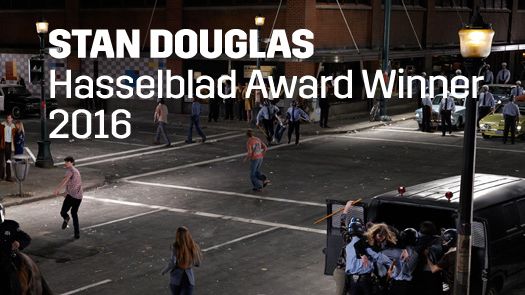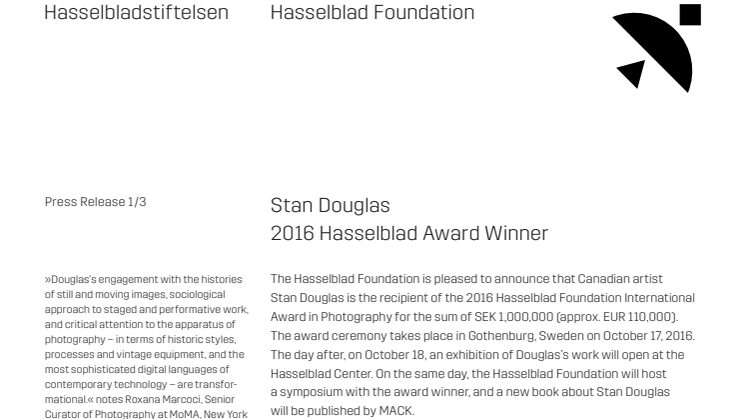
Press release -
Stan Douglas - 2016 Hasselblad Award Winner
STAN DOUGLAS
2016 Hasselblad Award Winner
The Hasselblad Foundation is pleased to announce that Canadian artist Stan Douglas is the recipient of the 2016 Hasselblad Foundation International Award in Photography for the sum of SEK 1,000,000 (approx. EUR 110,000). The award ceremony takes place in Gothenburg, Sweden on October 17, 2016. The day after, on October 18, an exhibition of Douglas’s work will open at the Hasselblad Center. On the same day, the Hasselblad Foundation will host a symposium with the award winner, and a new book about Stan Douglas will be published by MACK.
The Foundation’s citation regarding the 2016 Hasselblad Award Winner Stan Douglas:
An artist of outstanding significance, Stan Douglas has received international recognition for his powerful photographic art, as well as his work with video and film. His practice reflects carefully and poignantly on the history of photography and film, offering new understandings of the cultural and technological developments of both media. Furthermore, Stan Douglas has an open and highly innovative approach to both analogue and new digital formats. At the heart of his work lies a strong interest and commitment to social issues of race, gender, identity and post-colonial politics, whilst maintaining a valuable self-critical perspective on the role of the artist in contemporary culture.
The Jury
The 2016 Jury, which submitted its proposal to the Hasselblad Foundation’s Board of Directors, consisted of:
Roxana Marcoci, Chair
Senior Curator of Photography, The Museum of Modern Art, New York
Elvira Dyangani Ose
Freelance Curator and Lector of Visual Cultures, Goldsmiths, University of London, London
Florian Ebner
Head of Photography, Museum Folkwang, Essen
Duncan Forbes
Co-Director and Curator, Fotomuseum Winterthur, Winterthur
Clare Grafik
Head of Exhibitions, Photographers’ Gallery, London
Roxana Marcoci, Chair of the 2016 Hasselbald Award Jury:
“Douglas’s engagement with the histories of still and moving images, sociological approach to staged and performative work, and critical attention to the apparatus of photography – in terms of historic styles, processes and vintage equipment, and the most sophisticated digital languages of contemporary technology – are transformational.” notes Roxana Marcoci, Senior Curator of Photography at MoMA, New York and Chair of the 2016 Hasselbald Award Jury.
Christina Backman, Managing Director of the Hasselblad Foundation:
“We are honoured to include Stan Douglas among the many distinguished Hasselblad Award Winners. This award strives to acknowledge outstanding achievements in photography, recognizing artists that are developing the medium in new and exciting directions. Stan Douglas’s interdisciplinary work bridges the gap between photography, film and the performing arts in an innovative way, while at the same time engaging in pressing social issues.” states Christina Backman, Managing Director of the Hasselblad Foundation.
Click here to see the announcement video with Stan Douglas
Stan Douglas Biography
Stan Douglas was born in 1960 in Vancouver, where he currently lives and works. He attended the Emily Carr College of Art + Design from 1979 to 1982. From 1982 to 1983, he made installations with projected slides, which he presented in movie theatres. In 1989 his first series of short works for television, the twelve Television Spots (1988), were broadcast in Saskatoon and Ottawa amid regular programming, as if they were commercials. Unidentified, the short scenes depicting open-ended, banal activities baffled viewers. In 1992 Douglas’s Monodramas (1991),were broadcast on Toronto and Vancouver television to similar effect. That same year, the artist edited and designed the book Vancouver Anthology: The Institutional Politics of Art (1991). In 1992,as the guest of the Centre Georges Pompidou,he created Hors-champs,which looks at the free jazz developed by African American expatriates in Paris in the 1960s. In 1997–98, he worked on a series of photographs, Detroit Photos, that document the devastated American city and its auto industry. A related film installation, Le Detroit, was completed in 1999. Through the Detroit projects, he pursued an interest in the interrelationships between people and urban spaces in North America.
Working mostly as a film director, Douglas has the ability to orchestrate large casts, costumes and stage design to revisit historic moments. His critically acclaimed photographic series Crowds and Riots (2008) explores crowd phenomena in the twentieth century in his native Vancouver. In a more recent photographic project, Midcentury Studio (2010-11), Douglas assumed the role of a fictional photographer, chronicling the rise of press photography in post-war North America, between 1945-1951. In his subsequent series, Disco Angola (2013), Douglas took on the identity of an early 1970s photojournalist portraying in parallel the civil war in Angola and the burgeoning underground disco scene in New York. His project probes wider political questions about the relationship between anti-establishment disco and revolutionary impulse. At its nascence disco lifestyle was an underground, late-night phenomenon in abandoned warehouses. Evolving out of funk and soul, it mobilized people of all ethnicities and sexual orientations. Cameroonian saxophonist Manu Dibango is credited for writing the first disco hit, the song “Soul Makossa” (1972), and the movement as a whole took much of its inspiration from the African continent.
Since the late 1980s Douglas has produced works that are layered with specific observations pertaining to the future of civil society and offers a profound analysis of the contemporary subject rooted in a range of source material that includes the writings of Franz Kafka, Samuel Beckett, Theodor W. Adorno and E.T.A. Hoffmann, and the films of Alfred Hitchcock, Akira Kurosawa and Orson Welles. His work engages the distance between the histories of photography and of cinema, always in relation to the contemporary spectator. Douglas also has a strong relationship to performance art, both as an artist performing as the photographers whose styles he inhabits, and as a director, working with performers to create the most stunning mise-en-scènes.
Douglas’s work has been featured in major group exhibitions, including the 1995 Carnegie International; the 1995 Whitney Biennial; the 1997 Skulptur Projekte Münster; the 1997 Documenta; the 1998 Berlin Biennial; the 2000 Biennale of Sydney; the 2001 Istanbul Biennial; the 2002 São Paulo Biennale; the 2002 Documenta; the 2005 Venice Biennale; and the 2011 Moscow Biennale, among many others. A selection of large-scale solo exhibitions of the past decade includes presentations at the Irish Museum of Modern Art (2015); Haus der Kunst, Munich (2014); Carré d’Art-Musée d’Art Contemporain, Nîmes (2013); Minneapolis Institute of Arts, Minnesota (2012); The Power Plant, Toronto (2011); Staatsgalerie Stuttgart and Württembergischer Kunstverein, Stuttgart (2007); and The Studio Museum in Harlem, NY (2005).
Stan Douglas is represented by David Zwirner Gallery, New York and London; and Victoria Miro, London.
Gothenburg, March 8, 2016
Hasselblad Foundation
Related links
Topics
The Hasselblad Foundation was established in 1979 under the terms of the last will and testament of Erna and Victor Hasselblad. The purpose of the Foundation is to promote scientific education and research in photography and the natural sciences. The Foundation’s annual international award for outstanding achievements in photography, is considered one of the most prestigious photography awards worldwide.
The Foundation holds a collection of photographic art focusing on the Hasselblad Award Winners and Nordic photographers. In the Hasselblad Center, situated in the Gothenburg Museum of Art, three exhibitions are shown annually, one of which presents works by the current year’s Hasselblad Award Winner. Further stipends for studies and residencies are awarded each year, and the Foundation itself is actively engaged in the field of academic and artistic research through the publication of books, organization of seminars, and other public events.

